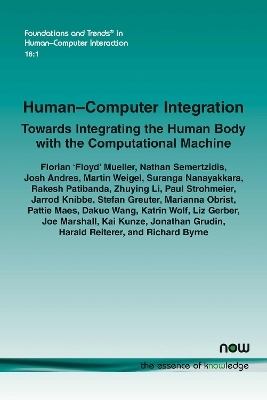
Human-Computer Integration
Towards Integrating the Human Body with the Computational Machine
Seiten
2022
now publishers Inc (Verlag)
978-1-63828-068-2 (ISBN)
now publishers Inc (Verlag)
978-1-63828-068-2 (ISBN)
Applies two key dimensions from psychology - bodily agency and bodily ownership - to enhance our understanding of Human-Computer Integration (HInt) systems; uses these two dimensions to provide new perspectives on user integration experiences; and uses the design space and its two dimensions to articulate HInt’s key challenges.
Human-Computer Integration (HInt) is an emerging paradigm in the human-computer interaction (HCI) field. Its goal is to integrate the human body and the computational machine. Because HInt is not an isolated area of research, the authors draw upon discussions from related perspectives, including cybernetics, augmentation, cyborgs, and wearables. While these prior works provide a basis for HInt, and some of their associated challenges also apply to HInt, the authors focus on articulating the HInt challenges that are of particular relevance to HCI.
The monograph makes three contributions: First, the authors apply two key dimensions from psychology – bodily agency and bodily ownership – to enhance our understanding of HInt systems. Second, they use these two dimensions to provide new perspectives on user integration experiences and to develop an integration systems design space. Third, they use the design space and its two dimensions to articulate HInt’s key challenges and group these challenges into four areas: design, society, identity, and technology. Ultimately, the work aims to facilitate a more structured investigation into human body and computational machine integration.
Human-Computer Integration (HInt) is an emerging paradigm in the human-computer interaction (HCI) field. Its goal is to integrate the human body and the computational machine. Because HInt is not an isolated area of research, the authors draw upon discussions from related perspectives, including cybernetics, augmentation, cyborgs, and wearables. While these prior works provide a basis for HInt, and some of their associated challenges also apply to HInt, the authors focus on articulating the HInt challenges that are of particular relevance to HCI.
The monograph makes three contributions: First, the authors apply two key dimensions from psychology – bodily agency and bodily ownership – to enhance our understanding of HInt systems. Second, they use these two dimensions to provide new perspectives on user integration experiences and to develop an integration systems design space. Third, they use the design space and its two dimensions to articulate HInt’s key challenges and group these challenges into four areas: design, society, identity, and technology. Ultimately, the work aims to facilitate a more structured investigation into human body and computational machine integration.
1. Introduction
2. Related Work
3. Design Space of Integration
4. The Bodily Agency Dimension
5. The Bodily Ownership Dimension
6. Bodily Integration Design Space
7. Challenges
8. Conclusion
Acknowledgements
References
| Erscheinungsdatum | 10.10.2022 |
|---|---|
| Reihe/Serie | Foundations and Trends® in Human-Computer Interaction |
| Verlagsort | Hanover |
| Sprache | englisch |
| Maße | 156 x 234 mm |
| Gewicht | 124 g |
| Themenwelt | Informatik ► Software Entwicklung ► User Interfaces (HCI) |
| ISBN-10 | 1-63828-068-1 / 1638280681 |
| ISBN-13 | 978-1-63828-068-2 / 9781638280682 |
| Zustand | Neuware |
| Haben Sie eine Frage zum Produkt? |
Mehr entdecken
aus dem Bereich
aus dem Bereich
Aus- und Weiterbildung nach iSAQB-Standard zum Certified Professional …
Buch | Hardcover (2023)
dpunkt Verlag
CHF 48,85
Lean UX und Design Thinking: Teambasierte Entwicklung …
Buch | Hardcover (2022)
dpunkt (Verlag)
CHF 48,85
Wissensverarbeitung - Neuronale Netze
Buch | Hardcover (2023)
Carl Hanser (Verlag)
CHF 48,95


